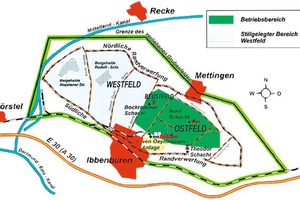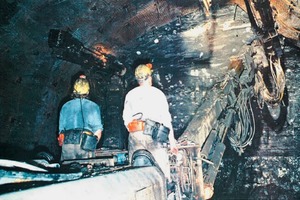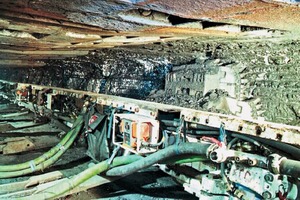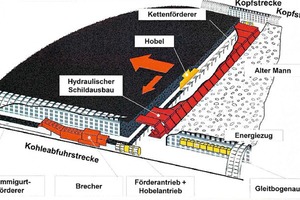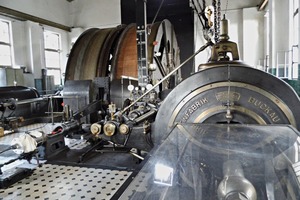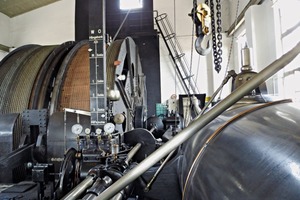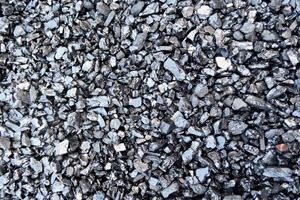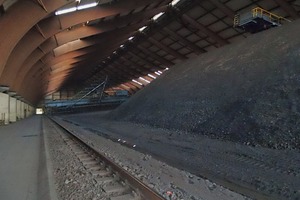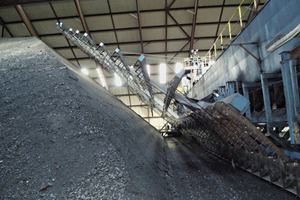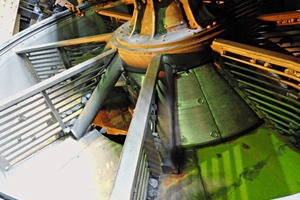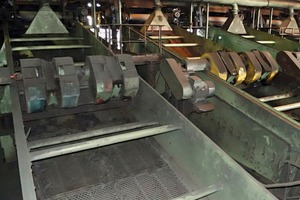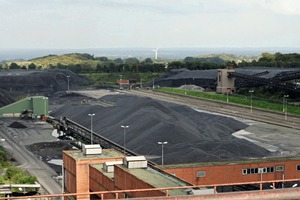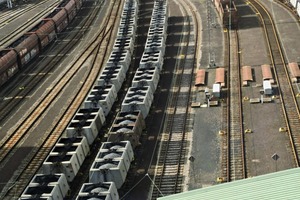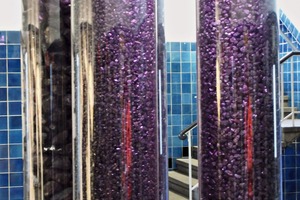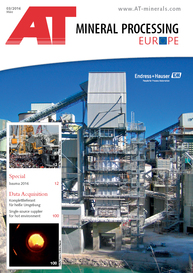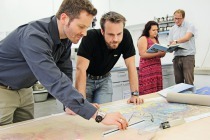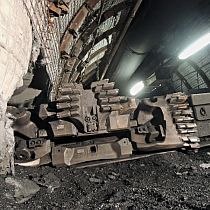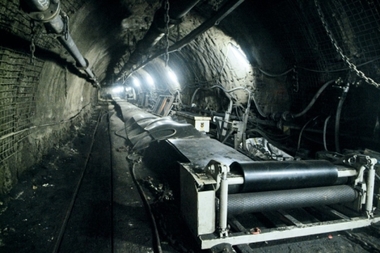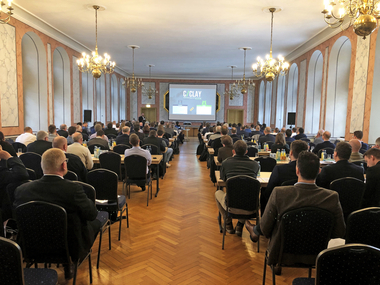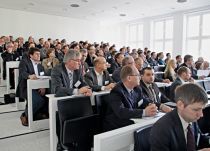One of the last opportunities
Fifteen members met on the occasion of this year’s GDMB annual meeting of the expert committee ‘Processing and Environmental Technology’, which was held in Rheine and Ibbenbüren from September 22 to 23, 2015. The choice of the venue was determined by the destination of the excursion, the RAG Anthrazit Ibbenbüren.
The opening of the meeting was followed by a number of specialist lectures, with the first speech being held by Prof. Dr.-Ing. Goldmann from the Institute of Mineral and Waste Processing, Waste Disposal and Geomechanics at the TU Clausthal. Under the topic of “German and European Initiatives on the Safeguarding of Raw Materials – an Update”, he presented the most important European programs on the focus topic of Safeguarding and Efficiency of Resources. Forecasts assume that the world population will see an increase to 11 billion people, but without further significant growth afterwards. This raises the question of the availability of resources. At the moment, the major raw materials groups are fighting a price war. In the end, the question is, which groups and companies will be able to prevail. Then, an increase in raw material prices is to be expected. The production sector is the main pillar of the German economy, thus raw materials are required. An essential way of extracting raw materials, which will become even more important in future, is recycling. Below, Prof. Goldmann presented a number of research programs as well as the participating research institutions. Auf dieser Grundlage ist Horizon 2020 “the biggest EU Research and Innovation programme ever with nearly 80 billion € of funding available over 7 years (2014 to 2020) – in addition to the private investment that this money will attract. It promises more breakthroughs, discoveries and world-firsts by taking great ideas from the lab to the market”1. On the one hand, the research program wants to contribute to bridging the gap between research and market and shall, for the first time ever, pool the different EU research programs. Another research association is GERRI – “The German Resource Research Institute”. The aim of this initiative is the identification of national raw material competencies, infrastructures and strategies within the virtual institute GERRI, and their targeted adaptation. The coordination of the virtual institute is carried out by the HIF, which belongs to the Helmholtz-Zentrum Dresden-Rossendorf (HZDR). Two other projects of interest in the field of recycling are the REWIMET – Recycling Cluster Economic Strategic Metals Lower Saxony – and the CReED, the Center for Research, Education and Demonstration in Waste Management, a German national association for research and education in waste and resource management.
“The funding measure r4 ‘Raw Materials of Strategic Economic Importance’ of the BMBF” was presented by Dr. Torsten Zeller from the CUTEC Institute (Clausthal-Zellerfeld). Within the context of this project, solutions and ways shall be found to recover raw materials of strategic economic importance either in the form of primary or secondary raw materials and to make them available to economy. Background of this research project is the rising demand for such raw materials. In the focus here are metals such as platinum group metals, steel stabilizers, electronic metals and rare earths. For these important metals, such as indium and lithium, an established recycling process does not yet exist. However, with increasing e-mobility, the necessity of recycling will certainly get more and more urgent.
After a refreshing coffee break, Dr.-Ing. Rudolph Leutz from Leutz Consult went into his “Studies on the Improvement of the Output of South African Chrome Ore”. In 2007, a chrome ore deposit was discovered near Pretoria. LANXCESS, the operators of the mine in Rustenberg, estimate 80 million tons of chrome ore. Dr. Leutz presented the various separation and enrichment processes examined as well as their results.
Afterwards, Dipl.-Ing. Jürgen Beimdieck, RAG Anthrazit Ibbenbüren GmbH vividly prepared the audience for next day’s excursion. In his lecture entitled “Production and Processing at the Ibbenbüren Mine”, he went both into the plant equipment and the development until the planned phasing-out in 2018. The RAG Anthrazit Ibbenbüren belongs to the RAG, which in turn is 100 % owned by the RAG Foundation, in which Evonik Industries has a 68 % share. In Ibbenbüren, anthracite coal of high quality is extracted in depths of up to 1600 m. Anthracite coal is characterized by the very high carbon content of over 90 % and the great brilliance (see Fig. 7). Due to the high energy content and the hot flame as well as its almost residue-free combustion, anthracite coal is deemed to be the coal sort of highest quality.
In Ibbenbüren, this anthracite coal has been mined for about 500 years. In 2014, approx. 1.9 million tons were mined with an excavation performance of 8101 m. The mining claim amounts to altogether 92 km² with a road system of 90 km (Fig. 1). The largest part of the mined anthracite coal – about 1.5 million tons (2014) – was converted into electricity in the neighboring power plant of the RWE Power AG. A small part – 0.4 million tons – went into the heat market. The deposit directly adjacent to Ibbenbüren is divided into the West compartment, which was closed in 1978, and the East compartment. The main sites – the Von-Oeynhausen shaft and the north shaft – are situated in the East compartment, which is still active. The Von-Oeynhausen shaft includes coal preparation, coal deposit, workshops, coal shipping with the related train station, the training center plants for power supply and the administration, while the north shaft accommodates the men rope haulage (passenger transport), material supply and disposal, the refrigerating system as well as the administration of the mine operation. The entire colliery employs a total of 1764 people along with, currently, (as of 09/2015) 100 trainees.
The thickness of mineable coal seams ranges between 0.9 and 3 m. The seams are relatively flat, therefore the development of the mine occurs via seams. The drift excavation is carried out exclusively by drilling and blasting operations (Fig. 2), while the roads are secured through combined support: the first step is strata-bolting, in the next step, the adit is equipped with a steel arch, while in a third step it is filled with construction material. The coal is extracted by using longwall ploughs with longwall caving. The face length ranges between 250 and 300 m (Fig. 3 und Fig. 4). Then a chain conveyor arranged behind the plough transports the extracted coal to the coal haulage roadway. On its way out of the mine, the coals of different seams are blended and equalized prior to their processing.
The run-of-mine coal with unit sizes of 0 to 400 mm is sieved at 80 mm. The screening output passes directly to the raw coal homogenizing stockpile, while the coarse refuse is previously sorted out from the screen overflow. The recyclable coarse fraction is then crushed to < 80 mm and also transported to the raw coal deposit. From there, the coal reaches the pre-classification where it is separated into three fractions. The fractions 10-40 mm and 40-80 mm are then sorted in the coarse grain washing on a jigging machine or in dense-medium separators and classified into four sorts of nut coal of different grain sizes. The sorting of the fraction 0-10 occurs on a jigging machine in the fine grain washing process. Recyclable superfine grain (< 1 mm) is recycled from the slurry of the scrubbing water clarification in the flotation system. The coal mine premises provide storage capacities for 2.0 million tons of steam coal and 250 000 tons of egg coal. The neighboring RWE power plant is directly supplied via conveyor systems, other customers by lorry, rail or inland water vessels. The resulting heaps of coal are transported to coal dumps.
Following this very comprehensive and illustrative description of anthracite mining and processing and after a short break, the get-together in the evening afforded the opportunity to talk shop about various interesting topics while enjoying a delicious dinner.
The following day began quite early with an excursion to RAG where – after a short introduction – we put on the clothes intended for the trip into the mine. Equipped with filters, pit lamps and beverages, we went down underground to 1200 meters. After having set out for the coal it was easy to see why the regulations for the transport of passengers are so rigid. It was nice and warm (felt 30 °C), the road climbed steadily uphill and we had some weight attached to our belts. After a distance of about 2.5 km,
we reached the seam 7/8 west 51 where we had the unique opportunity to examine the planers and the shield support directly on site, as mining was suspended due to maintenance work. Our way back was particularly interesting, since we could “drive” back lying comfortably on the conveyor belts. In the afternoon, the processing plants were on the agenda – among other things, a steam powered hauling engine from 1913 was waiting for us, which has been serving shaft 1 in Ibbenbüren since 1928.
After two days full of interesting lectures, discussions and an almost unique opportunity to visit the Ibbenbüren anthracite mine, the participants said goodbye. Very special thanks go to Dipl.-Ing. Jürgen Zuchowski, Management of the GDMB e.V., who was responsible for the excellent organization of these two days.

